During my recent 43-day journey through Southeast Asia, I enjoyed exploring Hanoi, Huế, Quảng Trị, Da Nang, and Ho Chi Minh City in Vietnam, followed by visits to Singapore, Penang in Malaysia, and ending in Jakarta, Indonesia. It was another memorable adventure, filled with breathtaking sights, awesome cuisine, and unforgettable encounters with locals. Throughout my travels, I took nine flights (with four long-haul flights in business class). Additionally, I stayed in nine hotels and happily worked in six airport business lounges.
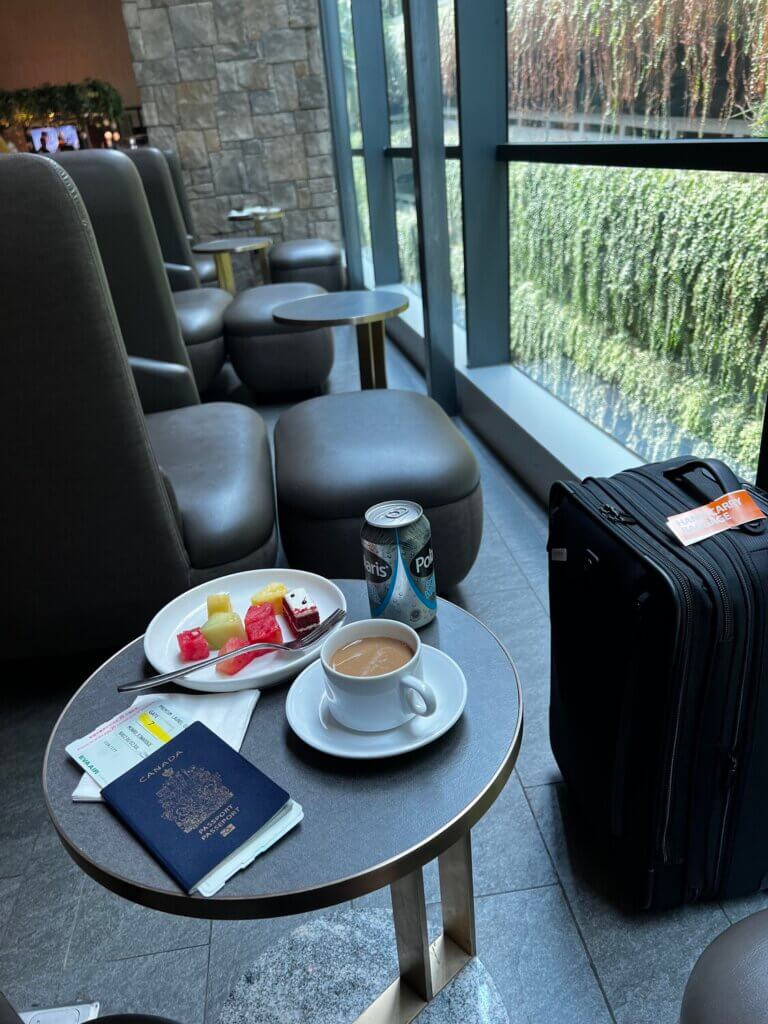
Grabbing a bite to eat before working from the EVA Air lounge in Jakarta
The airport lounges offer a peaceful environment to work and enjoy a meal. I highly recommend using Priority Pass to access various lounges whenever traveling in economy class. Once I clear security, I make a beeline for the lounge, find a comfortable spot, grab food and a drink, open my laptop, plug in my earphones, and spend a few hours working and relaxing before my flight.
However, it wasn’t solely about relaxation; juggling work and meetings when managing a 14 or 15-hour time difference from Pacific Daylight Time had its challenges. I was committed to many internal and client meetings, so getting a good night’s sleep was a luxury I didn’t have, as I never managed to secure 8 hours of rest. Instead, for six weeks, my sleep patterns consisted of brief periods of 1 to 4 hours at a time during the day and then on and off in the evenings and early morning periods. Not ideal, but I made it work.
Approaching Overseas Travel with a Work Mindset
When embarking on such trips, I adhere to a simple rule: consider the travel destination a work trip. Like those attending conferences or out-of-town client meetings, I view these journeys as an opportunity to accomplish work tasks while still planning my free time to explore the sites.
I find it beneficial to spend at least three days in each location, allowing me to experience what would typically be a one-day sightseeing itinerary for a tourist and spreading it out over 2-3 days.
On this extended trip, I spent six days in Hanoi, seven in Huế, seven in Da Nang, seven in Ho Chi Minh City, four days in Singapore, six in Penang, four in Jakarta, and two travel days. While work takes precedence, I knew beforehand that I might not have the chance to visit all the recommended attractions, but over six weeks, that’s okay; I was in no rush.
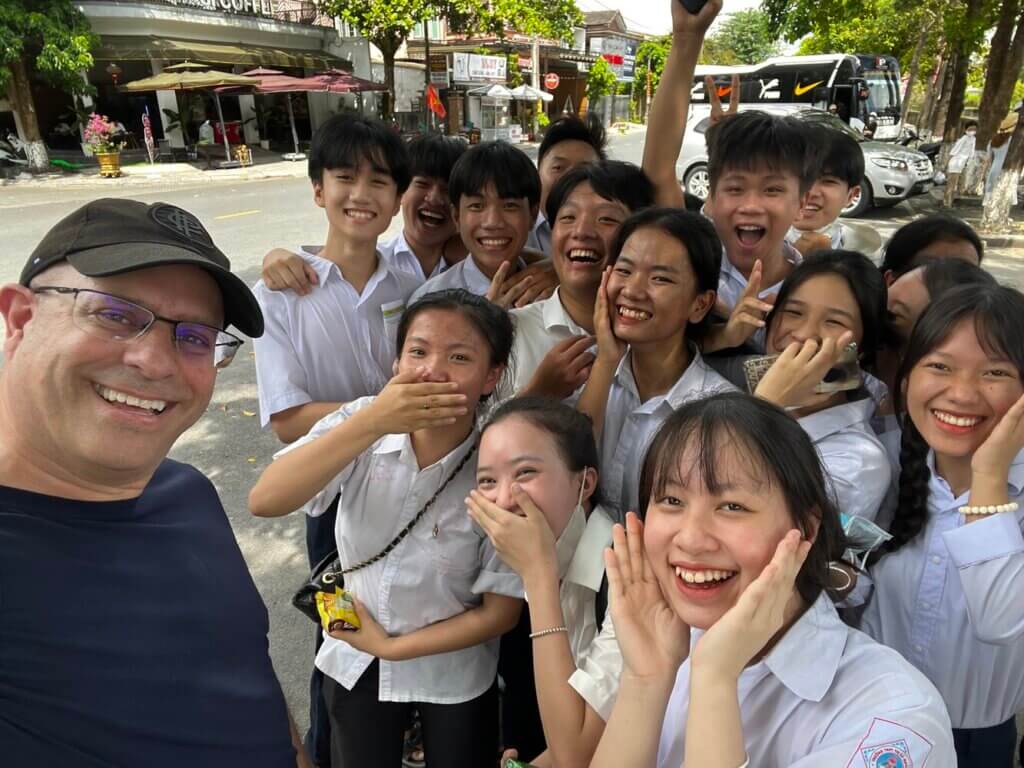
Saying hello to some happy students during my brief visit to Quảng Trị, Vietnam.
Adapting Work Schedules to Southeast Asia Time Zones
Dealing with the time difference presented some unique challenges in managing schedules. For example, when I had a meeting at 9:00 AM PT, it corresponded to 11:00 PM in Huế, while a meeting at 2:00 PM PT meant it was 5:00 AM in Singapore.
To handle these situations, I made adjustments to my sleep patterns. I experimented with new routines that allowed me to stay productive without succumbing to exhaustion due to late working hours – at least most of the time.
The Battle of Khe Sanh – 1968
While in Huế, I took a day trip to various historical sites, including Quang-Tri, Khe Sanh, the former DMZ, and the Vịnh Mốc tunnels used by the North Vietnamese for protection during bombing raids. It was quite moving to visit Khe Sanh on U.S. Memorial Day, and it was one of the most memorable moments of my trip. This day trip also stood out as unique as the rest of my trip consisted of a regimented routine.
My daily routine typically involved getting out to see the sights between 10:00 AM and 2:00 PM before returning to my hotel for a few hours of rest in the afternoon before starting my shift around 7:30 PM (5:30 AM PT).
I would work until around 2:00 AM, and if there were no subsequent meetings, I would nap for two to three hours. After that, I would continue working from 4:00 or 5:00 AM to 7:00 AM. Following this, I would take another brief nap for about an hour and then indulge in the breakfast buffet offered by the hotel.

Walking around Hoan Kiem Lake. Visiting Hanoi’s Train Street, Enjoying the local cuisine
The quality and variety of food at each hotel varied, but the Bespoke Trendy Hotel in Hanoi provided the most exceptional experience. Despite its unconventional name, it offered the best service and food of any of the places I stayed, plus the room was super comfortable.
One of the surprises I encountered in Hanoi was the number of people engaging in morning exercises around 6:00 AM. Hundreds of locals would walk and bike around Hoan Kiem Lake every morning, and for three days, I broke out of my sleep routine and joined in on the fun. It was such a cool experience walking alongside the locals and participating in their morning exercise routines.

While in Hanoi, I also visited the infamous Hỏa Lò Prison (AKA the Hanoi Hilton). Initially built by the French in the 1880s, the prison gained notoriety for its use of torture, such as restraining prisoners with leg irons fastened to the floor of their cramped cells and executing political dissidents with the guillotine. In later years, during the Vietnam War, it became a place of confinement for American airmen, including John McCain. Seeing McCain’s flight suit and the prisoners’ uniforms was a sobering experience.
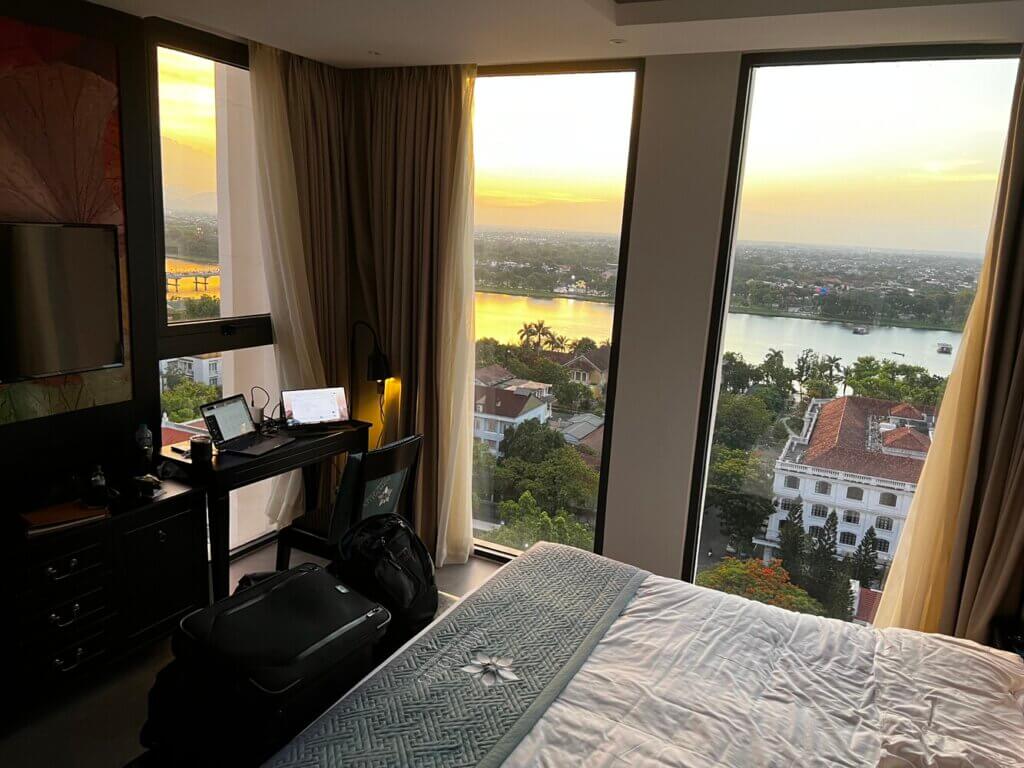
A view of the Perfume River from my remote work spot at the White Lotus Hotel in Huế, Vietnam.
Overnight Shifts and Sacrificing Evening Activities
Working these overnight hours from Monday to Friday (with weekends dedicated to morning work) often meant missing the opportunity to go out for dinner or check out evening entertainment activities.
However, this was not exclusive to my this trip to Southeast Asia; similar adjustments were made during my European and Middle Eastern travels.
The key is anticipating and accepting the work schedule without feeling like I am missing out (FOMO).
In Europe, I would get up around 6:00 AM and head out early to popular sites before the crowds swarmed in. I often had these incredible places all to myself, which was super cool. The situation was different in Southeast Asia, where I’d typically start my day by working early or getting a few hours of sleep before breakfast around 8:00 AM.
The Caravelle Hotel, Saigon
While in Ho Chi Minh City, I managed to find a great deal and stayed at the fabulous Caravelle Hotel.
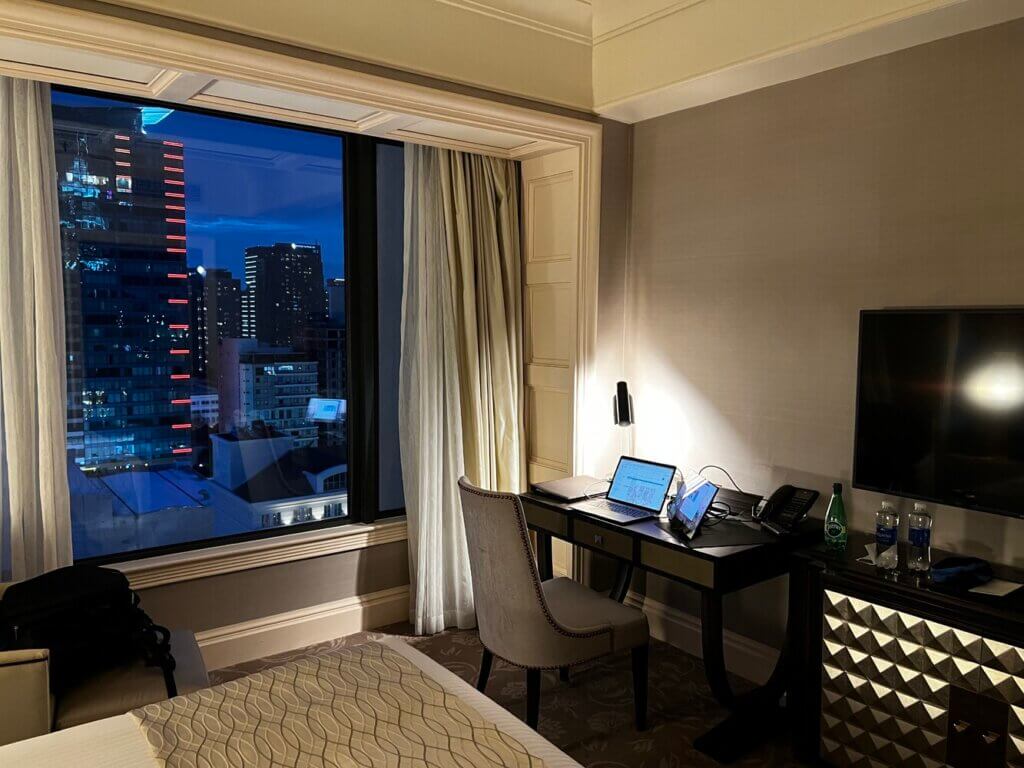
Fantastic remote work accommodation at the Caravelle Hotel in Saigon
This iconic hotel was a hub for news organizations and correspondents during the war. Today, it is a magnificent 5-star establishment with a rich history. Its rooftop lounge and terrace (where numerous famous photographs were taken) hold a special significance, especially as the war ended. Although I only stayed at the Caravelle for two nights, it was an incredible experience before moving to the more affordable yet pleasant Lotte Hotel for the remainder of my time in Saigon.
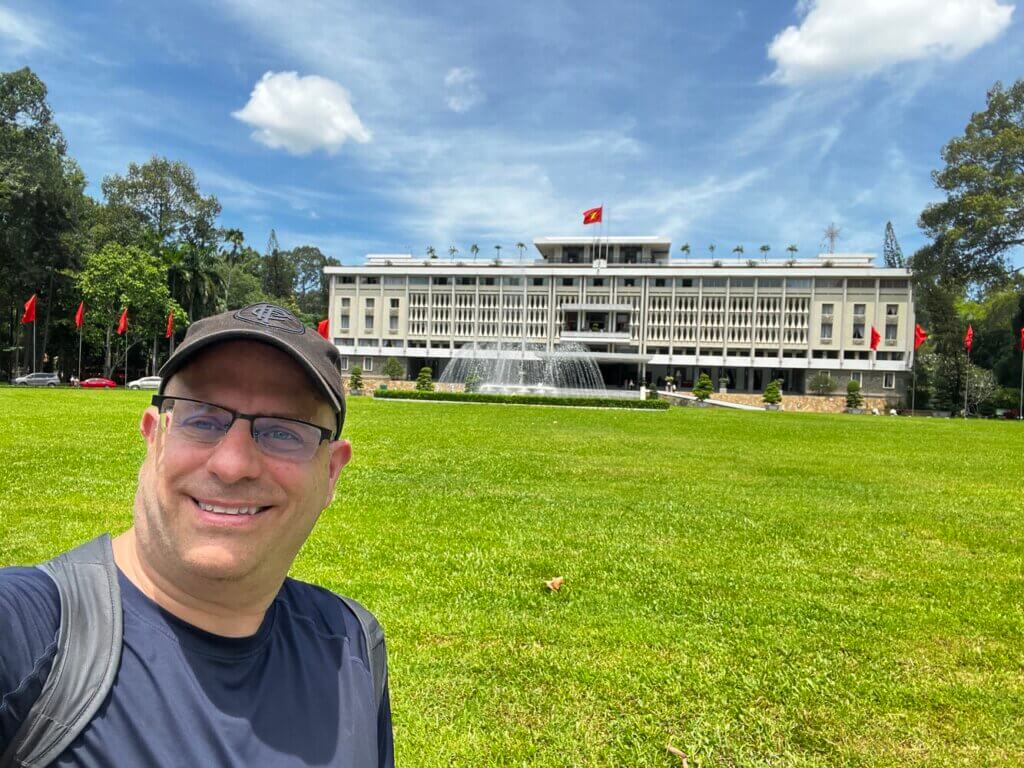
Independence Palace in Ho Chi Minh City, where the war ended on April 30, 1975
Visiting the former Presidential Palace, where the war ended on April 30, 1975, I recalled the TV images of North Vietnamese tanks crashing through the gates and a soldier running across the vast lawn with his Viet Cong flag ready to be raised. It was thrilling seeing it and walking through the interior in person.
Productive Days Amidst Stunning Surroundings
I made it a point to reserve one day a week to focus on reports and routine tasks. Sometimes this meant sacrificing the chance to explore nearby attractions, such as missing the Golden Hands Bridge outside of Da Nang.
During my six-week trip, I managed my responsibilities for all five clients thanks to these dedicated workdays – and, of course, with the support of my amazing colleagues at Leadtail.
As mentioned earlier, these workdays allowed me to stay on top of my work and provided me with opportunities to relax, such as the opportunity to swim in the pools at the White Lotus Hotel in Huế, the Caravelle Hotel in Saigon, and the OZO Hotel in Penang. Even when I was working in my hotel room, I occasionally took a break and appreciated that I was in an exotic location, which is the main reason I opt-in for remote work travel in the first place. I often say, “OMG, I can’t believe I am actually in _____ city!?!”
But, I did make a point to visit numerous noteworthy attractions during my travels. These included the war sites in Vietnam, the renowned Marina Bay Sands and Raffles Hotels, and the Cloud Forest in Singapore.
I also visited the house I used to call home, my former elementary school in *Penang and Jakarta’s historical Kota Tua (Batavia) area.
Reflecting on my journey, I realized I saw far more than I had initially anticipated.
(*As a kid, I lived in Penang for two years, completing kindergarten and grade 1. When I dropped by my school for a selfie out front, I was invited in, given a full tour, and signed their alum book. It was nice to see it again.)

The view of Georgetown from Penang Hill. My former school. The sunset from my room at the OZO Hotel in Penang and the lovely beach at Batu Ferringhi.
Strategizing Meal Times
To ensure I didn’t starve during the overnight hours, I would often buy two to three meals from local street vendors, grocery stores, or restaurants and store them in the refrigerator for my late-night lunches and dinners. I needed these meals readily available during these overnight hours, as I knew I wouldn’t likely have dinner plans (except on weekends).
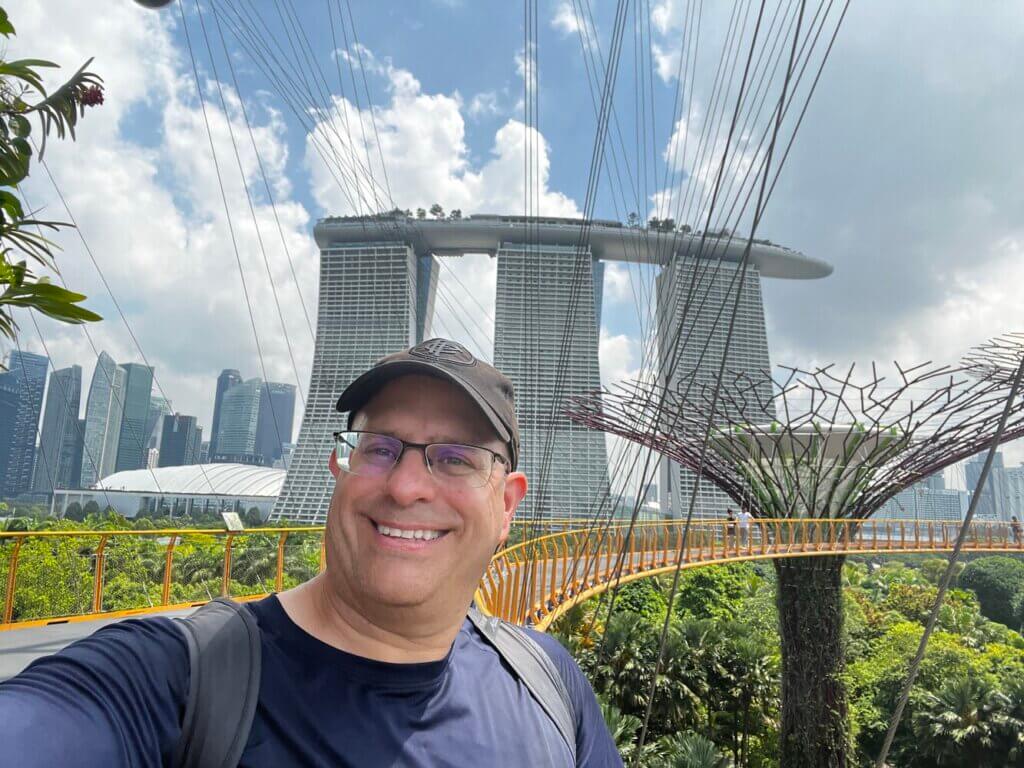
The Supertree Observatory and Marina Bay Sands in Singapore
Singapore was the ideal place to find a variety of Asian dishes that provided a refreshing break and much-needed energy at 2:00 AM. Although the food may not have always been hot, it was still delicious. Additionally, the Indian takeaway food in Penang was always tasty.
Was it worth it?
Overall, my six-week remote work experience in Southeast Asia was an incredible adventure that required careful planning and some adaptation to new sleeping habits.
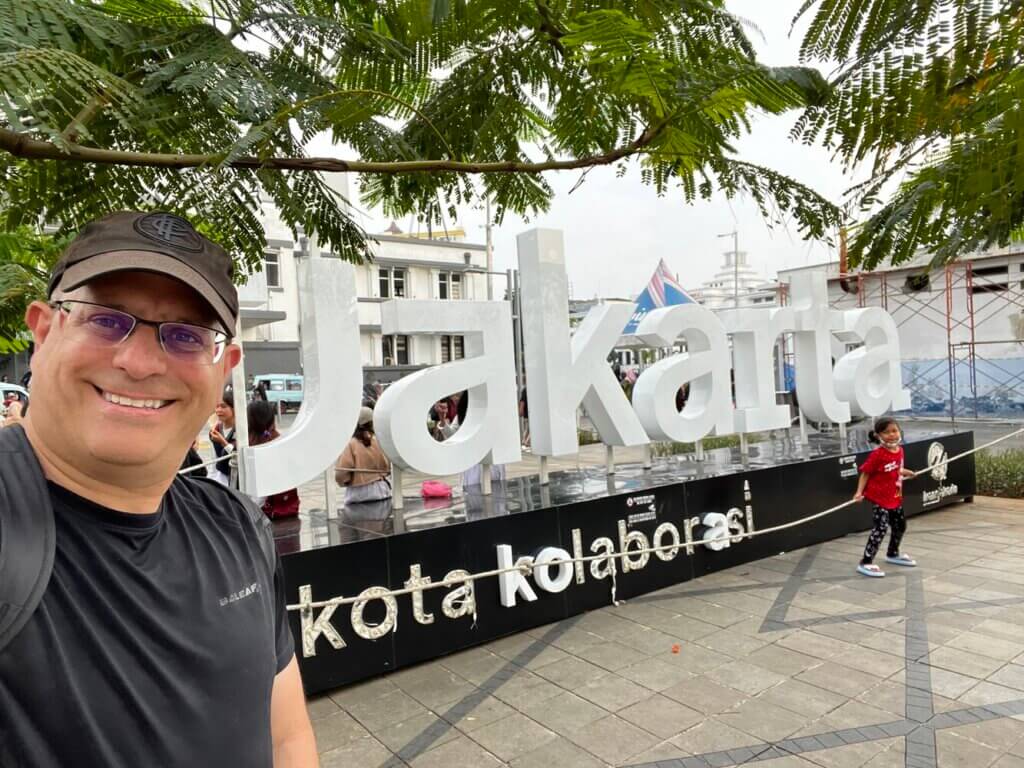
Visiting Kota Tua in the old Dutch area of Jakarta
Despite the annoying challenges presented by the time difference, I successfully managed to juggle my work obligations while exploring each city. More to the point, I often forget the details of the work at hand or the sleep deprivation after a trip, but I always remember the people, the sights, the yummy food, and, as always, the sheer excitement of visiting new places.
The financial and personal investment for long-term remote work travel pays off in many ways, but preparing and accepting the work-first mindset are the keys to a successful adventure. So, yes, it’s worth every penny and each lost hour of sleep!
Originally published on LinkedIn.
